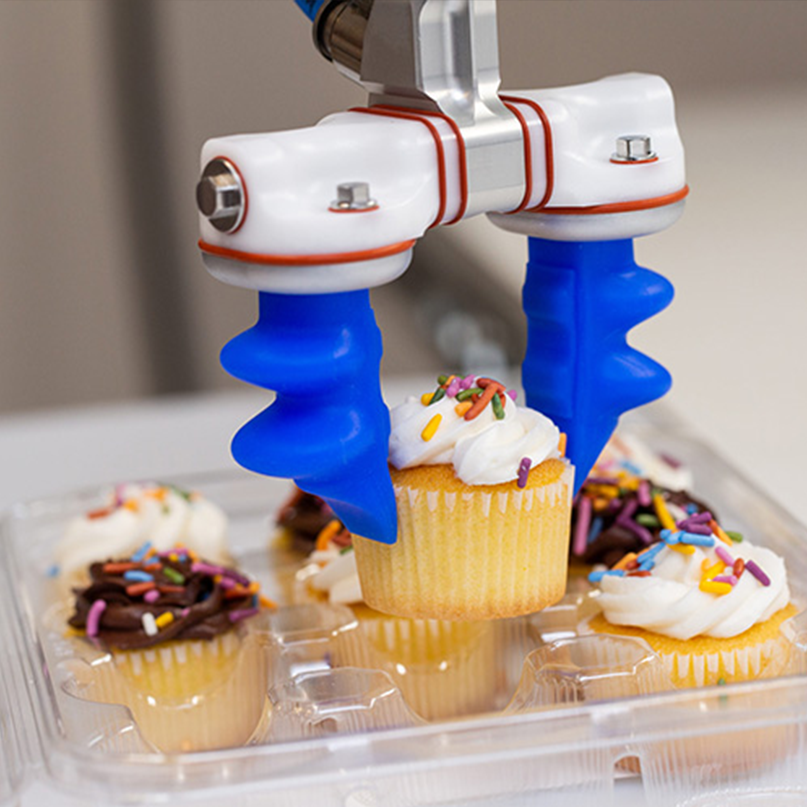EOAT သည် စက်မှုလုပ်ငန်းများတွင် ရိုဘော့စ်များ၏ စွမ်းရည်ကို မည်သို့ပြောင်းလဲနေသည်ကို ရှာဖွေတွေ့ရှိပါ။ ၎င်း၏ အမျိုးအစားများ၊ အစိတ်အပိုင်းများနှင့် နည်းပညာများကို စူးစမ်းလေ့လာပါ။
? အီန်အိုအေတီ (EOAT) ဆိုတာဘာလဲ။
EOAT သည် စက်ရုပ်ခြေထောက်တွင်တပ်ဆင်ထားသော ပစ္စည်းများဖြင့် ဖွဲ့စည်းထားပြီး အစိတ်အပိုင်းများနှင့် ပစ္စည်းများကို တိုက်ရိုက် ဆက်သွယ်ပေးသည်။ ဤကိရိယာများသည် စက်ရုပ်၏ လုပ်ဆောင်မှုကို တိကျသော လုပ်ဆောင်မှုများသို့ ပြောင်းလဲပေးသည်။ ဥပမာ- ကိုင်တွယ်ခြင်း၊ ဆော်လျော်ခြင်း သို့မဟုတ် စစ်ဆေးခြင်း။ အထူးသဖြင့် EOAT များမရှိပါက စက်မှုစက်ရုပ်များသည် တစ်စုံတစ်ရာမှ မရှိသကဲ့သို့ ဖြစ်နေမည်ဖြစ်သည်။
ခေတ်မှီ EOAT များ၏ အဓိကလက္ခဏာများ ?
လုပ်ငန်းအလိုက် ဒီဇိုင်းထုတ်ခြင်း
အစိတ်အပိုင်းတစ်ခုချင်းစီကို အထူးလုပ်ဆောင်မှုအတွက် ဒီဇိုင်းထုတ်ထားပြီး ပစ္စည်းများကိုင်တွယ်ရန်အတွက် ဂရစ်ပါမှသည် သတ္တုများကို ဆော်လျော်ရန်အတွက် ဆော်လျော်သံများအထိ ဖြစ်သည်။ ဤအထူးဒီဇိုင်းသည် လုပ်ငန်းများကို တိကျမှုရှိစေရန် လေဆာဆော်လျော်ခြင်းကို 0.1 mm တိကျမှုဖြင့် ပြုလုပ်ပေးနိုင်သည်။
အဆက်မပြတ် ပေါင်းစည်းခြင်း
EOAT များသည် ရိုဘော့ပိုးလေးချိန်စွမ်းရည် (0.5 kg မှ 2,000 kg)၊ လက်တံအကွာအဝေးလိုအပ်ချက်များ၊ EtherCAT သို့မဟုတ် PROFINET ကဲ့သို့သော ကွန်ထရိုလာဆက်သွယ်ရေးပရိုတိုကောလ်များနှင့် ကိုက်ညီမှုရှိရပါမည်။ ISO 9409-1 နှင့်ကိုက်ညီသော အမြန်ပြောင်းလဲနိုင်သောတပ်ဆင်မှုသည် ဤစွမ်းရည်ကို ထုတ်ဖော်ပြသသည်။
သိတ်ဖြစ်သော အကြံပြုချက် စနစ်
နှိပ်စက်တွင် အတိအကျဖြစ်သော (±0.05N) ဖိအားခံစနစ်၊ တည်နေရာပြင်ဆင်မှုအတွက် 3D မြင်ကွင်းစနစ်နှင့် ကုန်ပစ္စည်းများကိုင်တွယ်ရာတွင် တုန်ခါမှုစောင့်ကြည့်စနစ်တို့ပါဝင်သော အဆင့်မြင့် EOAT သည် လုပ်ငန်းစဉ်အတွင်း စွမ်းရည်ရှိသော အပြောင်းအလဲများကို ခွင့်ပြုသည်။
? EOAT စွမ်းရည်ဇယား
1. ? ကိုင်မြှောက်ခြင်း/ထိန်းသိမ်းခြင်းစနစ်များ
စီးတွင်းဘလောက်များအတွက် သံမဏိမျက်နှာပြင်များနှင့် စက်ချုပ်ကိုင်တွယ်သည့်စက်
PCB ဘုတ်များအတွက် Bernoulli suction vacuum actuator
ဥပမာ- Amazon ဂိုဒေါင်မှ တစ်နာရီလျှင် ပက်ကေ့ချ်ပို့ဆောင်မှု 1,000 ကျော်ပြုလုပ်ခြင်း
2. ⚡ ကိရိယာများကိုကုသခြင်း
0.1 mm ကွာခြားမှုတိကျမှုနှင့်အတူ ဆော်ကျွန်းခေါင်းများ
50 mm သံပြားများကိုဖြတ်တောက်နိုင်သော ပလာစမာဖြတ်စက်များ
ဥပမာ- Tesla GigaPress သည် ချုပ်တည်းတပ်ဆင်မှုအချိန်ကို ၇၀% လျော့နည်းစေသည်
3. ? စစ်ဆေးရေးယူနစ်များ
10MP အမြင်အာရုံစနစ်သည် 0.02 မီလီမီတာ ချို့ယွင်းချက်များကို သိရှိနိုင်သည်။
အောက်စ်ကုန်းပိုင်း အပူချိန်ကွာခြားမှုကို စစ်ဆေးသော အောက်စ်ကုန်းပိုင်း အပူချိန်ကွာခြားမှုကို ဖမ်းဆုပ်သည်
ဥပမာ- Foxconn iPhone တပ်ဆင်မှုလိုင်း အရည်အသွေးထိန်းချုပ်မှု
4. ☢️ အထူးကစ်များ
ဓာတုစက်ရုံများအတွက် မီးဘေးကင်းသော ပိတ်ဆို့မှုများ
မီလီမီတာအောက် ခွဲစိတ်မှုများအတွက် အဏုမြူခွဲစိတ်ရေးကိရိယာများ
ဥပမာ- da Vinci ခွဲစိတ်ရေးစနစ်၏ တိကျသော ကိုင်တွယ်မှု
⚙️ ဇီဝအင်္ဂါဆိုင်ရာ အမြင့်စွမ်းအား EOAT
အက်တီဗေတာသည် အက်န်တီစတစ်ကုပ်ပါသော ကိုယ်ပိုင်ဆီလူးပေးသည့် လက်ချောင်းများအား အရာဝတ္ထုနှင့် တိုက်ရိုက်ထိတွေ့မှု ပြုလုပ်ပေးသည်။
ပီဇိုအီလက်ထရစ် မော်တာကဲ့သို့သော နည်းပညာများကို အသုံးပြု၍ မော်တာစနစ်သည် စွမ်းအင်ကို လွှဲပြောင်းပေးသည်။
အင်တာဖေ့စ်သည် အမြန်ပြောင်းလဲနိုင်သော ဘရက်ကတ်များအား ချိတ်ဆက်ပေးခြင်းဖြင့် ရိုဘော့စနစ်ကို ချိတ်ဆက်ပေးသည်။
ထိုကွန်ထရိုက်စင်တာသည် AI အယ်လဂိုရစ်သမ်များပါဝင်သော အိုင်ယူနစ်လင်းနစ်စနစ်ကို အသုံးပြု၍ လည်ပတ်မှုများကို စီမံပေးသည်။
? စက်မှုလုပ်ငန်းအလိုက် အသုံးပြုမှုများ
ကားလုပ်ငန်း- မိနစ်တိုင်းတွင် ၅၀ ကြိမ်အထိ ဆော်လျော်နိုင်သော ဆော်လျော်ရေးသေနတ်များ
အီလက်ထရွန်းနစ်- ကူးစက်ပစ္စည်းများထုတ်လုပ်ရာတွင် ESD လုံခြုံမှုရှိသော ဝေဖာများကိုင်တွယ်သည့်ကိရိယာများ
ဆေးဝါးလုပ်ငန်း- CIP/SIP သန့်ရှင်းရေးကို အလိုအလျောက်ပြုလုပ်နိုင်သော FDA နှင့်ကိုက်ညီသော ကိရိယာများ
စိုက်ပျိုးရေး- ပျက်စီးလွယ်သော စိုက်ပျိုးရေးထုတ်ကုန်များကို ရုတ်သိမ်းရာတွင် အားကိုကန့်သတ်ထားသော ပိတ်ဆို့ကိရိယာများ
? နောင်တွင်ဖြစ်စေမည့် တိုးတက်မှုပုံစံများ
ပြောင်းလဲနိုင်သော ပုံသဏ္ဍာန်
အလိုအလျောက် ပုံသဏ္ဍာန် ပြောင်းလဲနိုင်သည့် အလွှာသတ္တုများသည် လုပ်ငန်းများအလိုက် ကိရိယာများကို ပြောင်းလဲနိုင်စေသည်။
AI ကိုအသုံးပြုသော လွတ်လပ်မှု
ပြုပြင်မွမ်းမံပေးသည့် စွမ်းရည်မြှင့်တင်ရေး အယူအဆများသည် တစ်ကြိမ်တည်းမှာပဲ ကိုင်တွယ်ဆောင်ရွက်မှု နည်းလမ်းများကို အကောင်းဆုံးဖြစ်အောင် ပြုလုပ်ပေးသည်။
အသုံးပြုရလွယ်ကူသော စနစ်
ယူနီဗာဆယ် တပ်ဆင်မှုစနစ်သည် ပြောင်းလဲမှုအချိန်ကို ၉၀ ရာခိုင်နှုန်းအထိ လျော့နည်းစေသည်။
စက်မှုလုပ်ငန်းဆိုင်ရာ အင်တာနက် (IIoT) တစ်ပေါင်းထည့်ခြင်း
OPC UA ကဲ့သို့သော စက်မှုလုပ်ငန်းဆိုင်ရာ ပရိုတိုကောများမှတဆင့် တစ်ကြိမ်တည်းမှာပဲ စွမ်းဆောင်ရည် အခြေအနေကို ခွဲခြမ်းစိတ်ဖြာပေးခြင်း။
? အဓိကအချက်များ
EOAT သည် စက်ရုပ်၏ အလုပ်ဆောင်ရည်ကို ၆၀ ရာခိုင်နှုန်းထက်ပိုမို ဆုံးဖြတ်ပေးသည်။
စက်မှုလုပ်ငန်းတိုင်းတွင် စိတ်ကြိုက်ပြင်ဆင်မှုများက စက်ဝိုင်းအလုပ်အဆင်များကို ၁၅-၄၀% လျော့နည်းစေနိုင်သည်
ကမ္ဘာ့ EOAT ဈေးကွက်သည် ၂၀၂၈ ခုနှစ်အထိ ဒေါ်လာအမေရိကန် ၆.၈ ဘီလီယံအထိ ရောက်ရှိလာမည်ဟု မျှော်လင့်ရသည်
လဲလှယ်နိုင်သောစနစ်များသည် ၈-၁၄ လအတွင်း ရင်းနှီးမြှုပ်နှံမှုအကျိုးအမြတ်ကို ရရှိနိုင်သည်
(စာလုံးအရေအတွက်- ၄၈၀ | ဖတ်ရန်အချိန်- ၃ မိနစ်)


